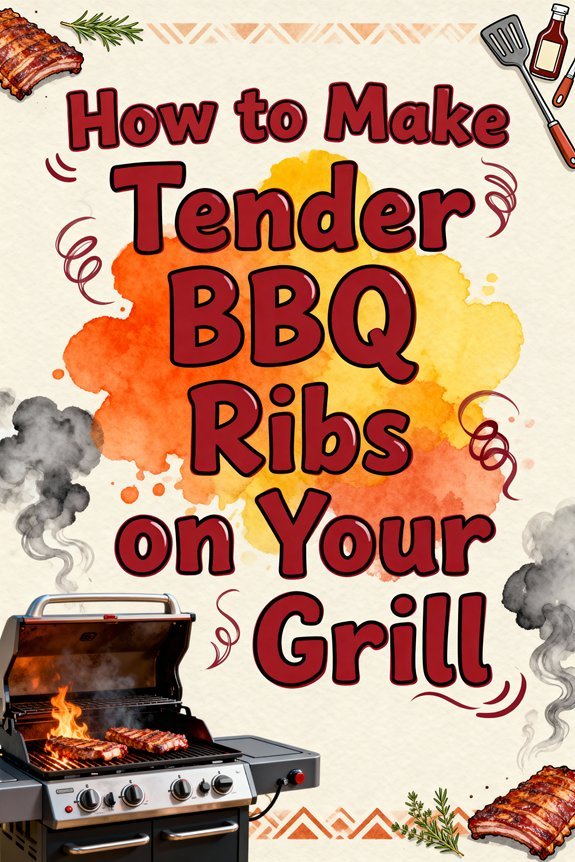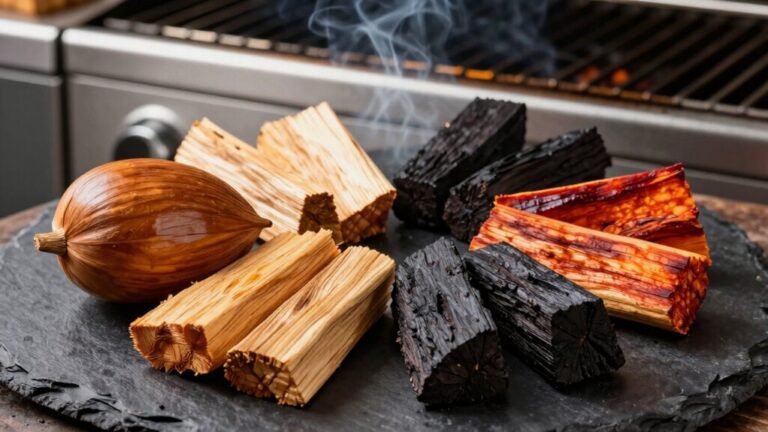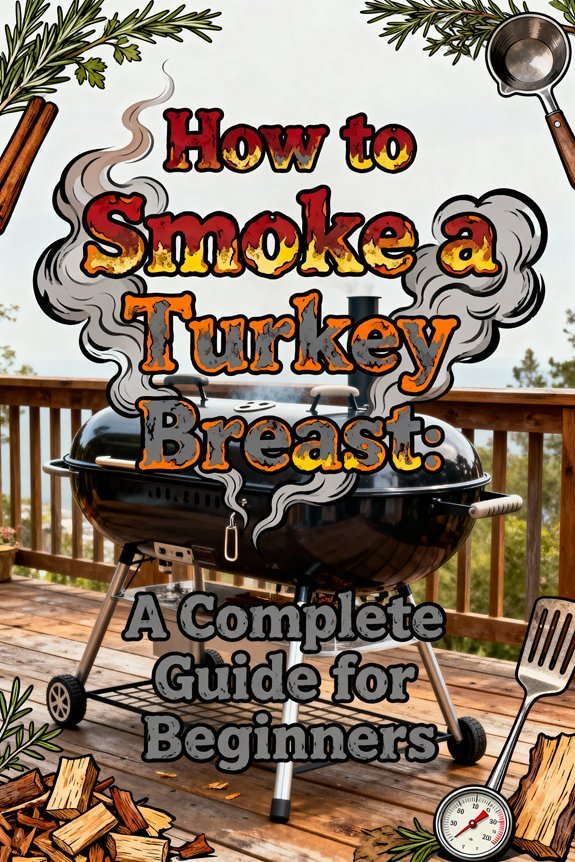You’ll make tender, competition-worthy ribs on your gas grill by mastering the essential 3-2-1 method. Start by setting up two heat zones and maintaining 225-275°F. Smoke the seasoned ribs for 3 hours unwrapped, wrap them in foil with liquid for 2 hours, then finish unwrapped for 1 hour while brushing with sauce. Test doneness when the meat pulls back from bones and reaches 195-203°F internal temperature. Master these techniques, and you’ll reveal the secrets of perfect backyard BBQ.
Essential Equipment and Supplies
Five essential tool categories will make or break your BBQ rib success: handling tools, temperature monitors, smoking accessories, rib supports, and safety gear.
You’ll need long-handled tongs and fireproof gloves for grilling safety, plus a sharp butcher knife for trimming. Don’t skimp on temperature tools – both an instant-read thermometer and grill thermometer are vital. For smoking, grab a smoker box and your choice of wood chips. A sturdy rib rack holder maximizes space and guarantees even cooking. Round out your setup with heat-resistant mitts, a drip tray, and proper ribs storage containers for prep work. Using mild soap and water to clean your grill’s exterior helps maintain its appearance and prevents rust. Add a spray bottle for moisture control and aluminum foil for the wrapping phase. Keep a grill brush handy for clean, stick-free grates and regular maintenance before each cooking session to prevent residue buildup. Premium brands like Twin Eagles offer superior quality grills and accessories for optimal rib cooking results.
[affiai keyword=”bbq grilling tools and accessories” template=”carousel” count=”3″
Preparing Your Gas Grill for Success
Before diving into the cooking process, you’ll need to properly set up your gas grill to create the perfect environment for tender, flavorful ribs. Pay attention to grill placement and ventilation considerations to guarantee ideal airflow and safety. Start by thoroughly cleaning your grates and oiling them to prevent sticking. Setting the right temperature is crucial, as ribs need to cook at 275 degrees for optimal results.
Just like with charcoal grills, clean ash removal helps maintain consistent temperatures throughout your cooking session. Create a two-zone cooking setup by turning off some burners, giving you better temperature control. Using a digital meat thermometer is essential for monitoring temperature precision, just as it is when smoking other meats. Preheat your grill to between 250°F and 300°F, and don’t rely solely on the built-in thermometer – use a reliable digital one for accuracy. For enhanced smokiness, make a foil packet with your chosen wood chips (hickory or apple work great) and place it over the lit burners. Let the grill stabilize at your target temperature before adding the ribs.
[affiai keyword=”digital grill thermometer for gas grills” template=”carousel” count=”3″
Selecting and Trimming the Perfect Ribs
Success in BBQ ribs starts with choosing the right cut and proper preparation. When selecting ribs, look for baby back ribs if you want leaner meat, or St. Louis-style cuts if you prefer meatier, uniform slabs. Choose racks with bright reddish-pink color, even thickness, and good meat coverage over the bones. Plate ribs deliver exceptional flavor due to their location on the animal’s active muscles.
Your trimming techniques will make or break your BBQ. Start by removing the tough membrane from the bone side – it’s essential for better flavor absorption. Trim away excess fat while leaving a thin layer for moisture, and square up the ends for even cooking. If you’re working with spareribs, remove the skirt meat and cook it separately. For precise cuts, chill your ribs briefly before trimming to firm up the meat. Low temperature braising before grilling ensures the meat will be tender and perfectly cooked. For optimal results, plan on indirect heat grilling for about one hour while maintaining a consistent low temperature.
[affiai keyword=”bbq rib trimming tools membrane remover” template=”carousel” count=”3″
Creating the Ultimate Dry Rub
With your ribs properly trimmed, it’s time to release their full potential through a knockout dry rub. Start with brown sugar and kosher salt as your foundation, then build layers of flavor with black pepper, smoked paprika, and garlic powder. Don’t skip the mustard powder – it’s essential for binding the rub to your meat and adding depth. Just as 350 degree heat produces juicy smoked burgers, the right spice blend is crucial for flavorful ribs.
You’ll find countless dry rub variations across BBQ regions, from sweet Kansas City-style to peppery Texas blends. For a classic spice combination, mix 2 parts brown sugar to 1 part salt, then add equal portions of paprika, black pepper, and garlic powder. Add cayenne for heat or cinnamon for warmth. Similar to the low and slow cooking method used in charcoal grilling, the flavors need time to develop properly. Apply your rub generously, pressing it firmly into every surface. Let it rest for 30 minutes before cooking to maximize flavor penetration. The airtight glass container storage method helps maintain freshness and prevents clumping for up to a month.
Setting Up Two-Zone Cooking
Two-zone cooking forms the backbone of perfect BBQ ribs, requiring you to create distinct temperature zones on your grill. On your gas grill, turn half the burners to medium-high or high, and leave the others off or very low. This two-zone advantage lets you sear the ribs on the hot side before moving them to finish cooking on the cooler side. The dual heat zones enable cooking different meats simultaneously if needed.
For ideal heat distribution, adjust your top vents to direct smoke and heat across the indirect zone. Keep bottom vents open for steady airflow. You’ll want to maintain temperatures between 180°F and 250°F on the cool side. Consider adding a water pan to stabilize temperatures and add moisture. Using a digital thermometer helps monitor temperatures precisely for consistent results. This setup prevents flare-ups and gives you complete control over cooking speed while breaking down tough connective tissues for tender, perfectly cooked ribs. For the most tender results, cook until ribs reach internal temp of 195-203°F.
Mastering the Smoke Generation Process
Proper smoke generation makes or breaks your BBQ ribs, demanding careful attention to wood selection and placement. Choose hardwoods like hickory, mesquite, or fruitwoods for the best smoke flavor, and soak your chips for 20 minutes before use. Don’t use pine or resinous woods – they’ll ruin your meat with bitter, harmful smoke. Direct heat should be completely avoided for proper low-and-slow smoking results. Temperature control is essential for achieving tender, flavorful meat over several hours of cooking. Just like with bone-in chicken, slow and gentle heat produces the juiciest results.
Create a foil pouch with 2 cups of soaked chips or use a smoker box, positioning it where the lit and unlit zones meet. You’ll need to replace chips every 45 minutes. Keep your grill at 225-275°F, using a two-zone setup with the wood over medium-low heat. Add a water pan to help smoke stick to your ribs, and keep that lid closed! Different woods offer unique flavors – try apple for mild, fruity notes or hickory for robust, bacon-like taste.
[affiai keyword=”bbq smoking wood chips for grilling” template=”carousel” count=”3″
Temperature Control and Monitoring
Maintaining precise temperature control separates mediocre ribs from mouthwatering perfection. You’ll want to keep your grill’s internal temperature between 225°F and 275°F, with 250°F being the sweet spot for low and slow cooking. For ideal temperature stability, set up your grill for indirect heat by lighting one side while placing the ribs on the unlit side. Multi-zone cooking lets you grill sides simultaneously while your ribs cook to perfection. While higher temperatures work well, low temp smoking at 180°F for 6 hours produces exceptionally tender results.
Don’t rely solely on your grill’s built-in thermometer – invest in a quality digital meat thermometer for accurate readings. Your ribs will reach peak tenderness between 190°F and 205°F internal temperature. Keep the lid closed as much as possible, and consider using a water pan to regulate heat. Remember, proper thermometer calibration is essential. When wrapping ribs in foil, you can safely increase the temperature to 285°F to speed up cooking without sacrificing moisture. For a hot and fast method, you can increase temperature to 300°F near the end of cooking, which helps caramelize sauce and reduces total cooking time.
[affiai keyword=”digital meat thermometer for grilling” template=”carousel” count=”3″
The 3-2-1 Cooking Method Explained
Now that you’ve mastered temperature control, let’s explore the foolproof 3-2-1 method for smoking ribs. This proven technique breaks down into three distinct stages: smoke, wrap, and sauce. During the initial smoking phase, heavy smoke is essential for developing deep flavors.
Start by smoking your ribs unwrapped for three hours at 225°F, spritzing every 30-45 minutes with apple juice to maintain moisture. Next, wrap them tightly in foil with a splash of liquid for two hours – this stage tenderizes the meat through gentle steaming. Finally, unwrap and brush with your favorite BBQ sauce, letting it caramelize for the final hour. For optimal tenderness, your ribs should reach 205-210°F internal when done. Before starting, ensure your grill grates are thoroughly cleaned to prevent any unwanted flavors from affecting your ribs.
Saucing and Glazing Techniques
The final stage of creating mouthwatering BBQ ribs comes down to masterful saucing and glazing. You’ll want to wait until your ribs reach 165-170°F before starting sauce application. Remove them from the foil and begin layering your sauce with a brush or spatula on both sides. Similar to smoking chicken drumsticks, using an instant-read thermometer ensures your meat reaches the proper doneness. Just like achieving perfect tri-tip results at 225 degrees Fahrenheit, maintaining consistent temperature control is crucial for tender, flavorful meat.
For perfect glaze timing, set your grill to medium-high heat and grill the sauced ribs for 5-7 minutes per side. Build up multiple thin layers of sauce during this phase – this creates that coveted sticky, shiny bark. Don’t rush this process. Mix some of the rib cooking liquid into your sauce for an extra-glossy finish, and consider spritzing with apple juice and vinegar between layers. Once glazed, let your ribs rest in indirect heat for 20-30 minutes to set that perfect coating. Be sure to combine your apple juice and apple cider vinegar in a foil pan before beginning the glazing process.
Testing for Doneness and Serving
After perfecting your glaze, knowing when ribs are done separates BBQ masters from amateurs. You’ll want to check internal temperatures between 195°F and 203°F, probing the thickest meat sections between bones. Don’t rely on temperature alone – look for telltale signs like meat pulling back from bones and a deep reddish-brown color with glossy rendered fat. Baby back ribs should be cooked to 198-200°F to maintain their juicy texture. 3-2-1 method offers a foolproof way to achieve perfect tenderness through staged cooking. Many pitmasters add moisture enhancers like butter and brown sugar when wrapping to ensure juicy results.
Perform your doneness tests after at least 3-4 hours of cooking. Try the bend test – ribs should flex with a gentle crack in the bark. Insert a skewer between bones; it should slide through easily. Once you’ve confirmed doneness through multiple tests, let the ribs rest briefly. Cut between bones to serve individual pieces, showing off that perfectly exposed bone and glistening bark. Serve hot with your favorite sides and sauces.
[affiai keyword=”digital meat thermometer for smoking ribs” template=”carousel” count=”3″







